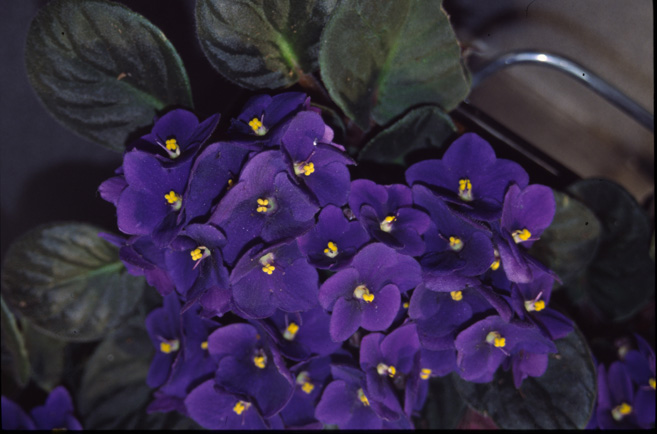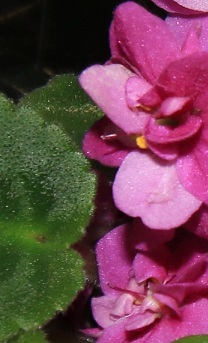Learn About African Violets and Other Gesneriads
African violets occur naturally is eastern tropical Africa (Tanzania and Kenya). When African violets are grown outside of their natural environment,
they need to be treated differently, with adjustments made to
compensate the changed conditions (e.g. lower humidity, less natural
light, colder temperatures). Then they can be grown successfully in almost every
part of the world.
Designed for the African violet enthusiast, this in depth course will teach you about:
- Propagation of African violets
- Cultivation and health of African violets and pests
- Commercial aspects of growing African violets
- Classification of African violets
- The exciting range of varieties available
Here's your chance to achieve outstanding results with African Violets!

Course Content
There are eight lessons including a special project in this course, as follows:
1. Introduction
- what is an African Violet
- other Gesneriads
- pronouncing plant names
- review of the system of plant identification
- Gesneriad sub families (Cyrtandroidae, Gesneriodoideae)
- review of African Violet species
- review of Saint Paulia groupings
- where to find more information
2. Culture
- understanding plant growth in African Violets (roots, leaves, stems, flowers)
- preferred conditions for African Violets
- nutrition and fertilisers
- soils, pH and potting media
- choosing a container
- potting up method
- Review of Gesneriad Genera: Achimenes, Aeschynanthus, Columnea, Episcia, Streptocarpus, etc
3. Propagation
- sexual and asexual methods
- propagating aids (greenhouse, hotbed, cold frame, fluorescent lights etc)
- cutting propagation of African Violets
- seed propagation of African Violets
- propagating African Violets by division
4. Pests & Disease
- understanding routine plant maintenance to maintain health
- understanding parasitic and non parasitic problems
- controlling problems (wet, cold, wind etc)
- review of pests and diseases (affects on African Violets and their control)
5. Light and its Affects
- understanding light
- affects on African Violets
- artificial lighting
6. Greenhouse Culture
- providing conditions for African Violets
- dealing with low humidity
- types of greenhouses
- greenhouse systems (heating, cooling, lighting, atmosphere controls, etc)
- shade houses
- cold frames
- heated propagators
- environmental controls (temperature, moisture, humidity, fog, etc)
- managing heat, ventilation, lighting, etc)
- managing water
- irrigation options and methods
7. Ways to Use African Violets
- Containers
- baskets, terrariums, miniature gardens
- hydroponics
- in the ground, in greenhouses, growing for profit (to sell etc.)
- popular African Violet cultivars, by colour
8. Special Assignment
A major problem based learning project designed to achieve the following aims:
- Identify a series of possible locations for growing a collection of African Violet Cultivars.
- Compare and select the best location from the available options.
- Identify factors that will affect the successful culture of African Violets in the selected location.
- Determine criteria for selecting cultivars of African Violets to be included in the collection.
- Select cultivars of to be included in the collection.
- Choose plant establishment techniques appropriate to the project.
- Determine a routine 12 month maintenance program for a selected collection of cultivars to be grown in a specified situation.
Duration: 100 hours
Course Aims
- Describe how African Violets and related plants are classified and the plant naming system
- Describe the cultural requirements of African violets
- Select appropriate propagating materials and using them, propagate African violets.
- Identify and control pest and diseases of African violets
- Discuss the role that light plays in the growth of African violets
- Describe greenhouses and other environmental control equipment used for growing African violets.
- Describe the various ways in which African violets can be grown
- Demonstrate the knowledge acquired for a specific group or individual plant in the Gesneriaceae family through research.
Become So Much More Familiar with African Violets and their Relatives
 African violets belong to a diverse group of plants called "Gesneriads". Some others in the group are well known and widely cultivated, including Streptocarpus, Gloxinia and Columnea. There are many lesser known genera that also belong to the gesneriads.
African violets belong to a diverse group of plants called "Gesneriads". Some others in the group are well known and widely cultivated, including Streptocarpus, Gloxinia and Columnea. There are many lesser known genera that also belong to the gesneriads.
All gesneriads have fibrous roots but one way of dividing them into cultural groups is on the basis of whether they have underground storage organs. This means grouping them as tuberous, scaly rhizomatous or fibrous-rooted for those that lack rhizomes or tubers. The root system consists of a primary root and lateral roots which spread from the basal part of the stem which is usually underground.
Fibrous rooted gesneriads
Most gesneriads are fibrous rooted those that are tuberous and rhizomatous also have fibrous roots. Those that are typically fibrous rooted alone lack the storage tubers or rhizomes. Other than epiphytic gesneriads which can withstand short dry spells, fibrous rooted gesneriads do not tolerate dry conditions for as long as those with storage organs; the soil that they are growing in should never be allowed to completely dry out.
Fibrous rooted species also include some epiphytic species e.g. Aeschynanthus, Codonanthe, Columnea, Nematanthus and also some species of Sinningia. Epiphytes are those plants that grow on other plants for support – they are not parasitic in that they do not rob the plant they are growing on of nutrients but use nutrients that are available from plant debris found within the supporting plants crevices etc.
Tuberous gesneriads
Sinningia are tuberous gesneriads, forming storage organs likened to potato tubers but more often pear shaped or flattish. These tubers help them to withstand drought conditions. The tuber may be below ground but is often exposed above ground i.e. be ‘caudiciform’. An example is Sinningia, where only the bases of the roots are below the ground and the tubers sits on top of the ground. This above ground part is referred to as a ‘caudex’. The size of the tuber differs with the species and also the age of the plant some are known to grow to 1metre in diameter e.g. those of Sinningia macrostachya. Tuberous gesneriads usually have a dormant period where the plants vegetative and flowering parts die down after flowering and re-sprout the following season.
Scaly rhizomatous gesneriads
Examples of rhizomatous gesneriads are found in Achimenes, Gloxinia, Kohleria and Smithiana etc., the rhizomes form when the plants become dormant. The scaly rhizomes are underground stems with a similarity to long narrow pine cones or segmented grubs – these underground structures are made up of leaves that are modified into closely packed scales. Unlike most other rhizomes scaly rhizomes of gesneriads are small and have very little ability to store food. The rhizomes should be potted up once they show signs of breaking dormancy.
Stems
The stems can be short or long, and may be hairy or not. While most of what we commonly cultivate are low herbaceous plants or creepers; some are more woody and shrub like. Those species with short stems have shorter internodes so that the leaves emerging from the stem are more crowded, and in some the stem is barely visible. Some of these shorter stemmed plants have leaves forming in a basal rosette e.g. Saintpaulia, whereas others are said to be 'rosulate' since the leaves form a loose tuft rather than a tight swirl. Those with longer stems tend to have the leaves situated at regular intervals along the stem.
Leaves
Leaves are usually opposite (decussate) and simple. Less commonly, leaves are formed in a spiral arrangement, and this is usually so for those with leaf rosettes.